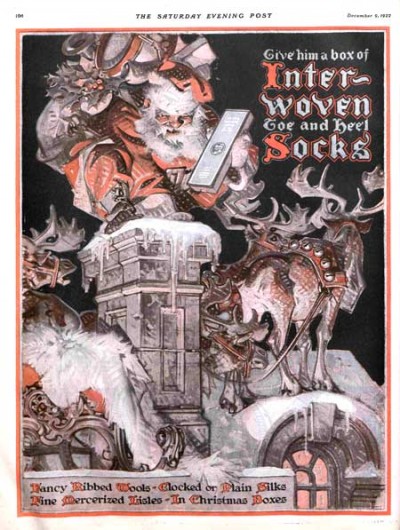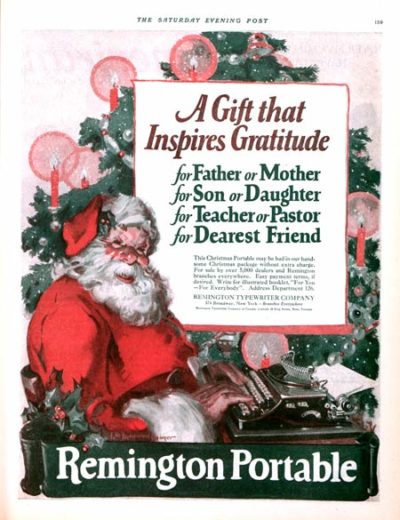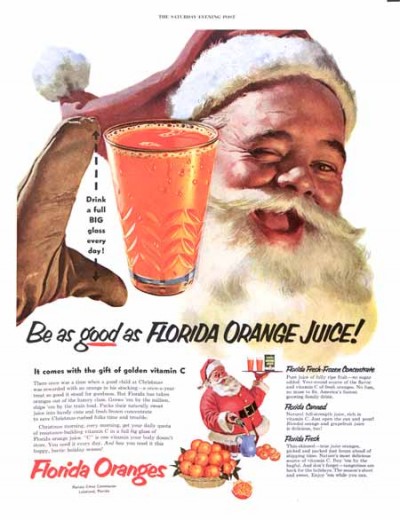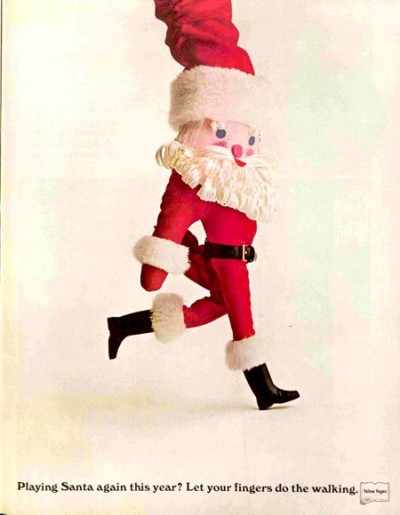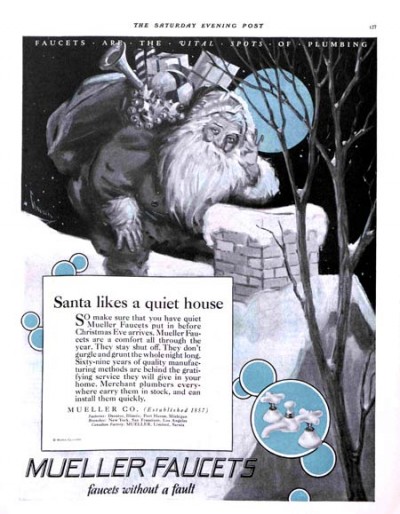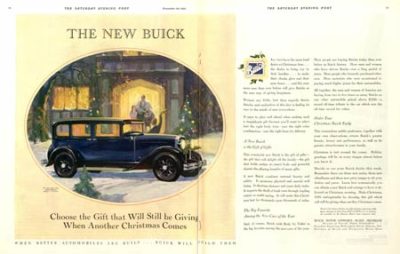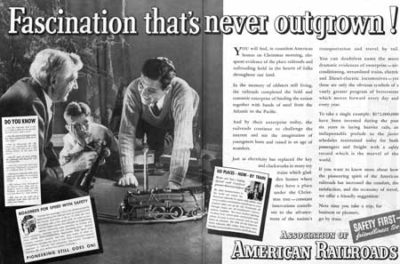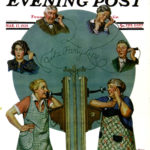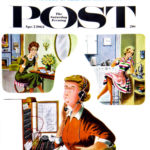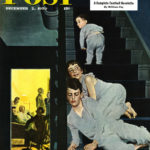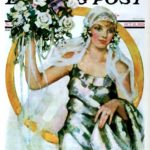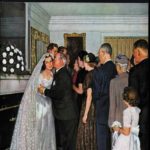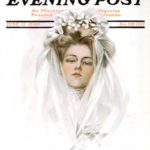Cover Collection: Yuletide Shopping Shenanigans
The commercialization of Christmas is not a modern phenomenon. Holiday shopping can be a joy, but it often veers toward comedy. In the hands of Post cover artists, the mundane experience of making lists, checking them twice, and finally scavenging neighborhood stores to gather up holiday bounty is presented as equal parts delight, misery, and just plain silliness.
Under the humorous guise of this painting’s subject matter, Norman Rockwell makes use of snow as white space to break the image of an overloaded grandfather into completely disjointed components. It’s not quite a human being we are looking at, but pieces of one—a subtle nod to cubism, perhaps?
Incidentally, “Pops” Fredericks, the model for this illustration, was an actor who never quite succeeded on the stage or the screen, but who achieved immortality on Rockwell covers as a cello player, a seasick cruise passenger, a hobo, Ben Franklin, Santa Claus, and a beloved doctor patiently examining a little girl’s doll.

This stunning self-portrait by one of the Post’s more popular female artists makes use of winter’s white in an unexpected way. Not only is the background washed out—evoking a sense of snow—but the gifts are a stunning white against the stark black of the subject’s mink. The multi-talented McMein, a Midwestern girl from Quincy, Illinois, and star pupil of the Chicago Art Institute, moved to New York City with dreams of succeeding as an artist, poet, or musician. The year before painting this cover, she traveled to war-torn Europe as a correspondent for McClure’s Magazine. In the mid-1930s she would make an indelible stamp on the marketing world by creating the face of Betty Crocker.

December 13, 1919,
Neysa McMein
The rocking horse was not new in 1909. It had been popularized in England during the 1800s, then galloped from small workshops into factory production. By the early 20th century, it was a staple toy in America and made frequent appearances on The Saturday Evening Post’s covers, especially around Christmas. Notice the detail in the harried commuter’s overcoat and pants. Leyendecker, whose roots were in fashion advertising, always gave close attention to the clothing of his models. A mentor to Rockwell, Leyendecker was also a darling of the public. At one point his fan mail eclipsed that of legendary film actor Rudolph Valentino.

January 11, 1941,
Spencer Douglass Crockwell
The clerk’s face, almost floating in a sea of returned gifts, says all that needs to be said about the post-Christmas letdown. With its emphasis on the commonplace, the Post (and much of America) was willfully ignoring the global crisis brewing across the oceans. (The attack on Pearl Harbor that galvanized our engagement in World War II was still 11 months away.) Notice the signature, bottom right. Crockwell, who illustrated 18 covers for the Post, took to signing his illustrations “Douglass,” “DC,” or simply “D” to avoid being confused with another Post cover artist with a very similar last name.
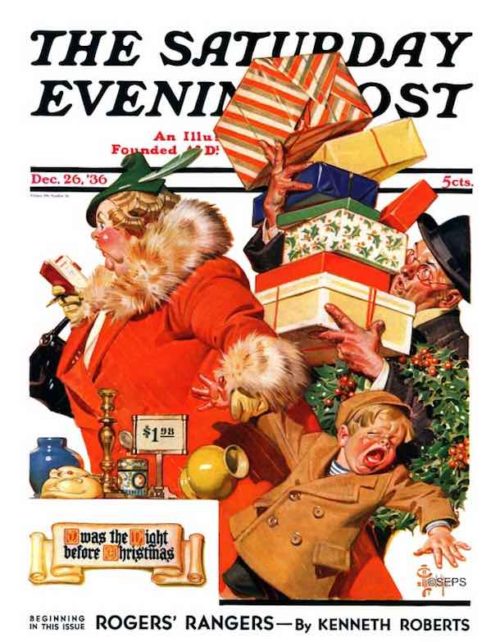
December 26, 1936, J.C. Leyendecker
Leyendecker was one of the longest running of the Post cover artists and certainly one of the most versatile. While best known for his stylish illustrations of fashionable people, he occasionally produced comic numbers, such as this colorful depiction of frantic, last-minute shopping. While many playful elements are at work, notice the visual pun of the bulky mom who bears an uncanny resemblance to St. Nick.

December 13, 1952, Stevan Dohanos
For this painting, Dohanos asked a man at a local nursery to
“saw me down a small Christmas tree to take out.” The little tree made this quirky cover in which all the players — duck included — seem remarkably complacent considering the circumstances. Post writer Rufus Jarman, a neighbor of Dohanos, makes a cameo appearance as the determined-looking man to the left of the tree.
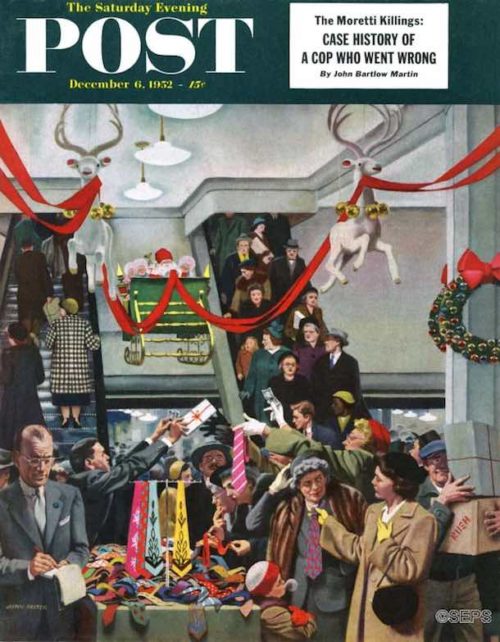
December 6, 1952, John Falter
Even 65 years ago, the ugly tie was universally recognized as the least desirable Christmas gift one could receive. But sometimes, well, that’s the best a person can do. For this hectic scene, Falter relied on his background working at his father’s clothing store in Falls City, Nebraska. By the late 1930s, Falter had moved to New York and was painting shirts and ties for Arrow Shirt ads before being discovered by the Post.

December 20, 1958, Thornton Utz
At the center of the image, a child at the Information booth will soon be reunited with misplaced parents. Meanwhile, countless other dramas are being played in Utz’s shopping pandemonium. Utz began drawing cartoons at 12 and knew he wanted to be an artist by the time he graduated from high school. But later he would say that he and a like-minded friend “could probably have been talked out of the whole idea if we’d been offered a good job driving a laundry truck.” With his knack for capturing humor in everyday situations, Utz became one of the most successful cover artists of the 1950s.
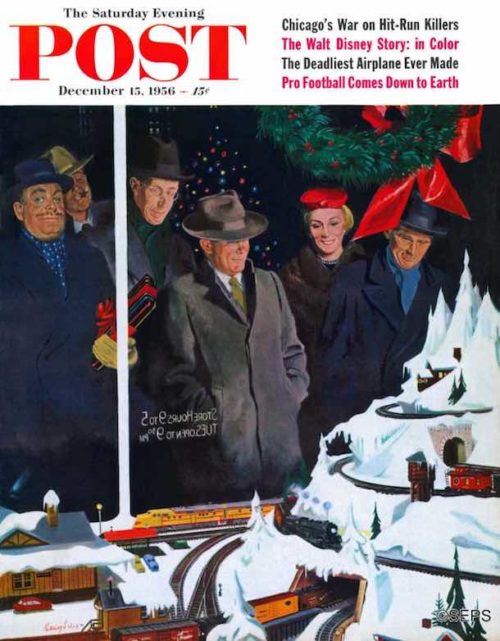
December 15, 1956, George Hughes
While drawing plans for a new home near Arlington, Vermont, Hughes decided to designate a room for his model trains. Months later, when breaking ground for his new home, his responsible side won out: He abandoned plans for the train room. But did he abandon his wish? One can almost feel the artist’s yearning for the magic of toy trains in this captivating holiday window display.
More Vintage Christmas Ads | Santa and Other Curiosities
Santa the Ad Man
More than one child must have been troubled by all these commercial Kringles. Why would Santa Claus appear in so many ads, urging people to buy gifts, when he and his elves were making all the gifts up at the North Pole?
Over the years, they saw Santa promote everything from gasoline to chewing gum, socks, typewriters, electric lights, orange juice, and antacid. Some of the more interesting versions of Santa can be seen in the 1920 ads for Interwoven socks and Kuppenheimer good clothes. They were created by the popular illustrator, and frequent Post cover artist, J.C. Leyendecker.
Here’s one weird-looking Santa from 1911:
Post cover artist J.C. Leyendecker illustrated this ad.
You can count on clothing ads to feature quality artwork.
Another Leyendecker Santa ad.
Done with Christmas, Santa begins work on his memoirs:
Santa’s elves, all hard at work making… appliances?
Whatever happened to flying reindeer?
Santa’s only request:
Still looking for gift ideas? Because everyone needs socks.
It doesn’t get more Christmas-y than this.
I guess he’s done with milk.
Even Santa needs an Alka-Seltzer sometimes.
Something’s off about this Santa…
Curious Christmas Ads
In an effort to cash in on Christmas sales, everybody from car manufacturers to tobacco companies to the United States government released Christmas-themed ads. In 1919, The Faultless Rubber Company tried to get in on the Christmas-gift-buying momentum to sell their baby bottles, hot water bottles, and enema bags. The American Chain Company used a Christmas theme to promote their tire chains and automobile jacks. Mueller Faucets selling plumbing fixtures by showing a rooftop Santa listening for dripping faucets in 1926.
Christmas is a time for giving, but it has also long been a time for buying and selling. Enjoy this selection of Christmas ads that have little to do with Christmas.
When I think Christmas, I think ‘rubber goods.’
Out of gift ideas? How about tire chains?
Here’s Santa with a sack full of knives.
Because Santa won’t go in if you have a leaky faucet.
If you want to go big, you can always give a Buick.
Is this Santa in space?
Lacquer: Another classic Christmas gift.
Who wouldn’t want to receive savings bonds on Christmas?
From model trains to the real thing.
Tobacco companies used to issue special holiday cigarette cartons.
You can make any ad a Christmas ad by adding a small child with gifts.
This Christmas ad’s a bit of a stretch.
Nothing says Christmas like ‘Pliofilm’!
Since so many people travel around Christmas, travel ads are a holiday fixture.
If dad wants a new Plymouth so bad, maybe he should ask Santa himself.
As travel became easier, luggage ads became more common.
Classic Covers: Can You Guess the City?
We admit these beautiful cities look different now than they did in 1946 or 1960, but these covers by artist John Falter are still a treat. How many can you guess?
Fifth Avenue
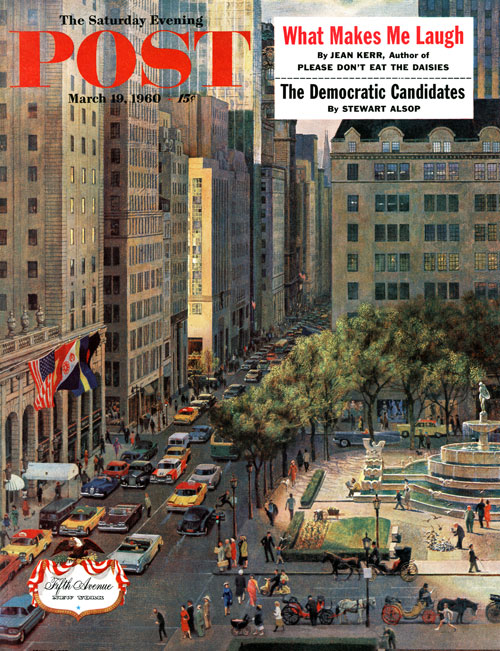
John Falter
March 19, 1960
This is one of the most famous streets in America, circa 1960. Next hint: the April sun in shining on the windows of Tiffany’s. Joggers, cars, horse and buggies, feeding the pigeons – so much detail that it was actually a fold-out cover. You can study it further or read on for the answer, as if you didn’t know: New York’s Fifth Avenue. By the way, you can click on any cover for a close-up.
Falls City, Nebraska at Christmas
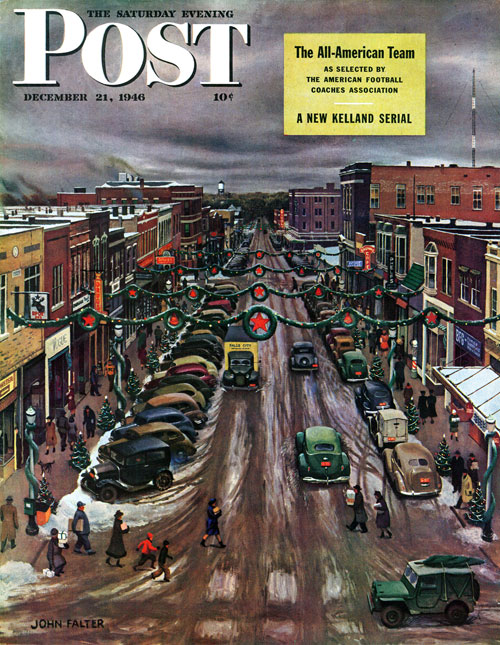
John Falter
December 21, 1946
A few weeks ago, Ruth Nixon wrote to us asking for John Falter covers. This one is of Falter’s (and Ruth’s) hometown of Falls City, Nebraska, Christmas time 1946. The future Post cover artist worked on this very street in his father’s clothing store. He had the exalted title of “pants runner”; he ran trousers from the store to the tailor’s to get them shortened. You have to love the cars in this one. Thanks so much, Ruth, for giving us the idea for this segment!
Monument Circle

John Falter
October 28, 1961
I knew this one instantly! I’d like to think it’s because I’m so darned smart, but actually it’s because I’ve worked in downtown Indianapolis and have had lunch out on Monument Circle on many fine days. Dedicated in 1902, the Soldiers and Sailors Monument is at the very heart of downtown. Again, the minute artist’s detail: A teeny-tiny group of school children are viewing the beautiful statues of soldiers and sailors – which, unfortunately, you have to be quite close to see how exquisite they are. The beautiful English Gothic Christ Church still stands, I’m happy to say, as does the neighboring Columbia Club building. Indy thanks you for this one, Mr. Falter.
Kansas City

John Falter
September 23, 1961
If this cover is any indication, this is one of the prettiest cities around. “Spanish architecture in Missouri?” the editors asked. “If such a state of affairs seems peculiar, consider that the unpredictable Show Me state even has a town named Peculiar, some twenty miles south of here.” “Here” is lovely Kansas City in 1961. The charming community of shops pictured here was conceived and built by Jesse Clyde Nichols (1880-1950) to whom the fountain in the foreground is a memorial.
Peachtree Street

John Falter
June 25, 1960
Let’s head south and see what people are doing on this fine June day in 1960. Construction workers are constructing (right of that big tree), pedestrians are pedestrianing, and traffic is flowing well on Peachtree Street in Atlanta. Get out the magnifying glass again, because the editors identified one of the teeny-tiny people to the far lower left: “ the gentleman on crutches is Ernest Rogers, Atlanta Journal columnist and the popular ‘Mayor of Peachtree Street’”. More editorial info: “In the early nineteenth century this was a sinuous ridgetop trail leading to an Indian settlement known as The Standing Peachtree; today it’s the main artery in the economic capitol of the South. That towering tree in the foreground is an American elm. Our scene contains no peach trees—they don’t thrive in downtown Atlanta.”
Michigan Avenue, Chicago
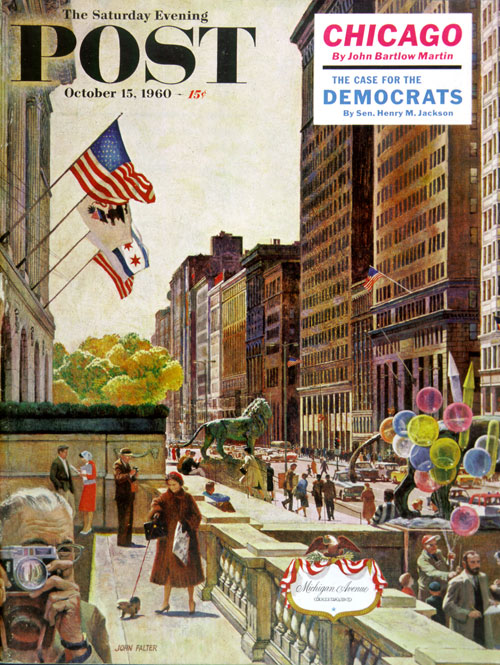
John Falter
October 15, 1960
We must not forget the Windy City. Again, there was so much wonderful stuff to show, this was a fold-out cover, but we can show you half. This is Michigan Avenue, looking north toward the Tribune Tower and the Wrigley Building. Where, you ask? Again, the incredible detail: “The Wrigley Building and environs are reflected in the camera lens at left”. You can tell it’s a crisp autumn day from the coats being worn and the changing leaves on the tree to the left. Another identifiable pedestrian: “The whiskered gent with the sketch pad is the late Louis Sullivan, Frank Lloyd Wright’s mentor and an architect who helped reshape the face of this frisky city.”
Town Square, New Castle, Delaware
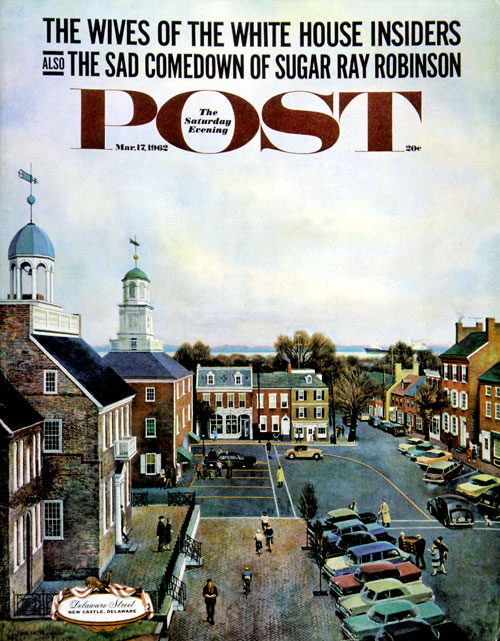
John Falter
March 17, 1962
I must add one more because this is such a charming cover. New Castle, Delaware was not a big city (pop. 4469 at the time of this 1962 cover), but it won over artist Falter. The editors shared some interesting history: “Founded in 1651, it was William Penn’s landing place when he came to America at in 1682. Penn is thought to have spent a night in the house at the extreme right of our cover. The spire atop the Court House (left foreground) was used as the center of a twelve-mile radius in part of the 1763-67 survey—to settle a boundary dispute—that resulted in the Mason-Dixon Line.” You thought the Mason-Dixon line was way down South, didn’t you? Nope. Personally, I’m interested in the people at the lower right of the cover trying to fit a lovely antique into a car trunk. It makes me want to go antiquing in New England. Well, maybe with a bigger vehicle.
Classic Covers: Listen to This!
“Eavesdropping” was a common theme for Post cover artists. If “curiosity is the very basis of education,” to quote writer Arnold Edinborough, then some very curious individuals on our covers have certainly learned a great deal. Perhaps more than they bargained for …
We hate to rat out a famous Post cover artist. But, alas, that is exactly what our editors did regarding the June 7, 1952, cover. Apparently, an interesting young lady was “number two” on the party line. When artist Constantin Alajalov was visiting Nantucket, number two rang and, according to Post editors at the time, “he, being alone at the moment, picked up the receiver and found that a young man was making romantic statements to a young woman. After eavesdropping for half an hour, the artist decided maybe he was eavesdropping, and hung up.” We’d like to report that is all, but there is no shame among snoops. Number two rang again, and “Alajalov found that it was the same girl and a different man …” The situation is getting rather sticky, isn’t it? The editors tell the rest of the story: “After a third different man had gone through the works, Alajalov was in love with Miss Ring Two himself. So then did he, a bachelor, marry the girl, and thus make us a swell story? He did nothing, the quitter, but paint a cover.” Well, we’ll settle for the Telephone Party Line cover, simply because it is fun.

Hotel Switchboard Operators
June 21, 1941
We also love Artist Lawrence Toney’s 1928 cover of two aproned matrons talking on the phone and four, count ‘em, four nosey neighbors listening in with various facial expressions. Alas, not one of those expressions is shame!
Being a switchboard operator provided a classic opportunity to eavesdrop on interesting conversations. In Albert W. Hampson’s 1941 cover, the young blonde lady is getting an earful indeed. Is she overhearing a cheating lover or, heaven forbid, a murder plot? Whatever it is, it is apparently scandalous.
We were surprised to find this behavior bouncing into in the 1960s. But not as shocked as Constantin Alajalov’s April 1962 operator! Whatever juicy secrets those two ladies are sharing have our lady-of-the-headphones stunned. Are the two hatching a homicide? Maybe they’re just talking about someone the astonished operator knows. Or thought she knew.
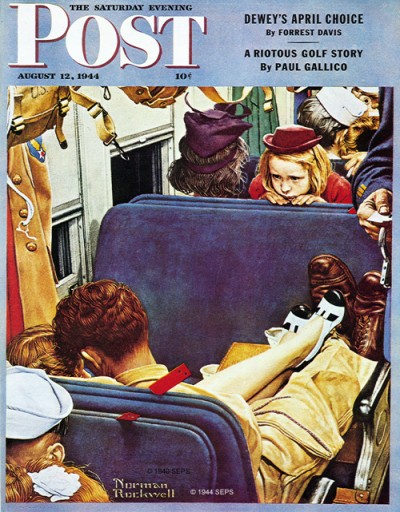
Travel Experience
August 12, 1944
You don’t need a switchboard or party line to eavesdrop. Just being a pesky little brother is license enough. George Hughes’ November 1949 cover shows Junior not only listening to big sis’ conversation (with a boy, no doubt), but relentlessly mocking her. We told you there was no shame among snoops. This same artist shows a young man listening in on the extension while his sister is on the phone. Any female who was, er, blessed with male siblings will tell you this is not uncommon behavior.
What kid doesn’t want to know what grown-ups are saying? While the youngsters in Hughes’ December 1950 cover are supposed to be tucked up in their little beds, they aren’t. Ears pressed against the banister, the two older ones are listening intently to adult secrets. Since this is a December cover, perhaps they’re hoping to unravel some Christmas gift mysteries.
Some of the most interesting eavesdropping is not what Mom and Dad or the neighbors are saying, but listening in on lovers. Who can resist? Mushy stuff must be going on behind the beach umbrella in Amos Sewell’s August 1960 cover, because the boy and girl listening in are finding the conversation hilarious. And let’s not forget Norman Rockwell’s famous Travel Experience cover (of a girl on a train) from 1944 showing the young lady in question watching unabashedly at the goings-on in the seat behind her. Perhaps she is getting more from her travel experience than her mom bargained for. And one of the cutest eavesdropping covers is Rockwell’s November 1936 cover showing a man attempting to read his book on a park bench. While he may look somewhat stuffy (spats, no less!), the gent is discovering that, at times, real life is more interesting than fiction.
Gallery
Telephone Party Line
June 7, 1952
Party Line
March 17, 1928
Hotel Switchboard Operators
June 21, 1941
Eavesdropping Operator
April 7, 1962
Eavesdropping on Sis
November 19, 1949
Eavesdropping on Sister
February 9, 1957
Eavesdropping on Grown-Ups
December 2, 1950
Eavesdropping on Love
August 13, 1960
Travel Experience
August 12, 1944
Overheard Lovers
November 21, 1936
Classic Covers: Rain, Rain, Go Away!
American poet and educator Henry Wadsworth Longfellow perhaps said it best: “Into each life some rain must fall, some days must be dark and dreary.” The rainy days on our Post covers show the dark and dreary, the frustrations along with the humor that accompanies a downpour. No fair weather friends, our cover artists!
Dating Rule No. 1: If trying to impress a girl with your fancy convertible, be sure a downpour isn’t in the works. In Albert W. Hampson’s 1936 cover, the young lady is clearly not impressed—whatever the make or model—when the rain comes. The expression on the young man’s face clearly says, “I have so blown it.” Well, at least she wasn’t wearing a lovely hat to ruin, such as the pretty lady in Douglass Crockwell’s April 8, 1939, cover. But she’s a clever lass—she’s pulling down the handy Post cover for protection!
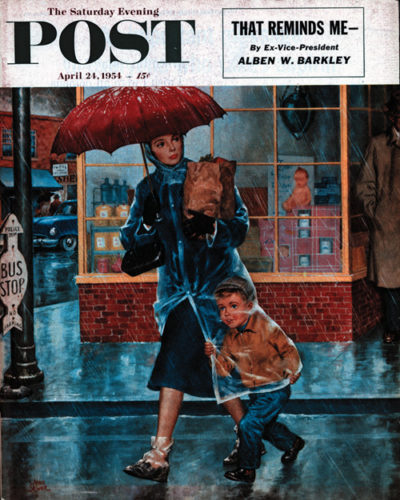
Boy Walking Under Mother's Raincoat
April 24, 1954
Also showing good ol’ American ingenuity is the young boy on Amos Sewell’s April 24, 1954, cover. Since mom’s raincoat is clear plastic, he figured out a way to walk in the rain, see where he’s going, and keep himself quite dry—well, at least the top half.
Downpours help us discover speed we didn’t know we had. In the 1950s, you not only worried about getting the top up on your convertible when a Midwest storm blew in, you had to scurry to get the laundry off the line. Artist John Falter remembered the “hair-curling lightning and thunder” in that part of the country from his boyhood, and his April 26, 1952, cover shows that Mother Nature clearly plans to take no prisoners. Also dodging raindrops are three charming ladies on John LaGatta’s colorful April 2, 1932, cover.

Constantin Alajalov
July 2, 1955
Let’s visit the local drive-in. Or is it the local float-in? On John Falter’s May 13, 1961, cover, our real-life hero protects burgers and shakes from the pouring rain as he scurries through the puddles to nourish his hungry troops. Rain or shine, the show must go on! Much more difficult than negotiating puddles to feed the family is cooking food in the rain, as seen in Constantin Alajalov’s July 1951 cover. You would think one of the slackers on the porch would at least hold the umbrella for the poor cook.

Ladies Running From Rain
April 2, 1932
Sarah Stilwell-Weber, who delighted Post readers in the early 1900s with her beautiful paintings of children, shows a girl walking in the rain, balancing schoolbooks and an umbrella on the October 9, 1909, cover. Having less luck with his umbrella is the gentleman in Robert Robinson’s March 18, 1911, cover. Holding on to your hat and an inside-out umbrella at the same time takes dexterity.
Another trio of beautifully dressed LaGatta ladies are getting splashed by a passing car in the May 20, 1939, cover. But leave it to a Post cover artist to find irony, as in one of our favorite rainy-day covers from October 2, 1948. Three pedestrians are being splashed by a passing truck. But not just any truck, dear friends, a delivery vehicle for the local dry cleaners.
On the bright side, our cover research found someone happy about the storms! Stevan Dohanos’ April 1946 cover shows gentlemen from the New York weather bureau delightedly noting the lightning storm outside. While there’s no fun getting wet, there’s a certain pleasure in getting it right!
Gallery
Girl with Schoolbooks in Rain
October 9, 1909
Man with Inside-out Umbrella
March 18, 1911
Ladies Running From Rain
April 2, 1932
Couple in Convertible
August 29, 1936
Lady in Hat in Rain
April 8, 1939
Ladies Getting Splashed
May 20, 1939
Weatherman Was Right
April 27, 1946
Splashed by Dry Cleaning Truck
October 2, 1948
Rainy Barbeque
July 2, 1955
Storm Coming
April 26, 1952
Boy Walking Under Mother’s Raincoat
April 24, 1954
Rain on the Boardwalk
July 2, 1955
Rainy Drive-In
May 31, 1961
Classic Covers: In Honor of June Brides
Oh my. There seems to be a conflicting view of married life already, and we’re only at the altar. In artist Constantin Alajalov’s June 1961 cover, the dreamy groom is visualizing a blissful married life, complete with breakfast in bed. Isn’t that the way marriage is? But it seems the lovely bride has visions of sugarplums served in bed as well, as no doubt he promised. We’re guessing reality is not far away for this charming couple.
In the montage Story of Love, also by Alajalov, there is the whole, well … story of love. We see “Miss Efficiency,” as the editors dubbed her, hard at work at her desk. Ah, but you never know what’s around the corner. In scene two, she is introduced to Mr. Right himself, then we see several dates and a wedding by scene six. Then a honeymoon, joyous bounce over the threshold, followed by Miss Efficiency, er, excuse us, Mrs. E., back at her desk again.
Philip Boileau, Post cover artist in the early 1900s, showed us a lovely (or a bit haughty) bride on the June 12, 1909, cover, and we’ve highlighted charming brides over the years, particularly striking examples being W. Haskell Coffin’s bride of September 25, 1926, and Ellen Pyle’s fetching bride with bouquet aloft on the October 13, 1928, cover. Do not fear that all was grace and charm in the early Post covers, dear reader. Artist Albert W. Hampson’s June 5, 1937, cover shows a bride kissing the best man … and a groom looking none too happy about it. We certainly hope there isn’t trouble in that paradise.
But we’re rather fond of the wedding realism of the 1950s. John Falter’s Backyard Wedding of June 24, 1950, is delightful, and Earl Mayan’s 1956 cover of “before and after” shows a wedding rehearsal in striking contrast to the actual event. In the top frame, well, we don’t want to say “what a bunch of slackers,” but we have a couple of yawns, a lady applying makeup, and a flower girl playing with a yo-yo (these days it would probably be a hand-held video game). But out of jeans, T-shirts, and without crossed arms and other expressions of “when is this going to be over?” the wedding party cleans up real good, as they say. We’re happy the wedding turns out beautifully—our hope for all June brides.
Stevan Dohanos



